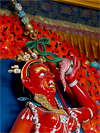|
dakini (डाकिनी)
Sanskrit. A
yogini
or female divinity of low rank in
Vajrayana Buddhism. There are two forms, malevolent and benevolent. There is a group
of five dakinis associated with the five
jinas, each holding a
jewel, a lotus, or a double thunderbolt. Her name is related to the Hindi word dakin (डाकिन),
meaning ‘witch’ and is sometimes translated as ‘sky dancer’, as she
‘carries the souls of the dead to the sky’. In this sense, a dakini is reminiscent of an
apsarsa, but may be distinguished
by the presence of a ‘third
eye’ or
urna
in the middle of the forehead. In
Hinduism, dakinis are female imps who
wait upon
Kali and feed on human flesh.
The malevolent Red Dakini (fig.) typically drinks from a
kapala (fig.), i.e. a cup made from a human skull, filled with human blood. She wears a necklace of human skulls, as well as a crown decorated with five human crania. She also carries a staff topped with a human skull and two severed heads, one blue ‒the other green, in one hand, while in the other she holds a
vajra-cleaver, i.e. a chopper with a curved, crescent-like blade and a vajra-handle, akin to a
vajra axe, and known in Sanskrit as a kartika (कर्त्तिका), literally a ‘dagger’. The Red Dakini is similar in manifestationto Vajrayogini, which is said to be an emanation of Narodakini, yet another Tibetan deity similar in appearance.
回






|

